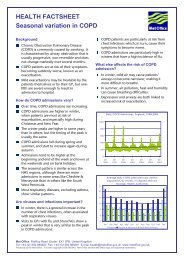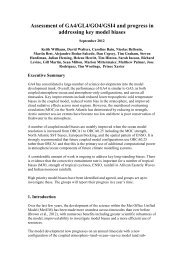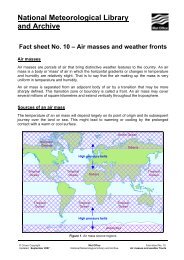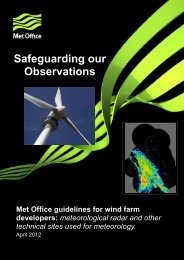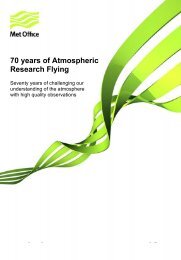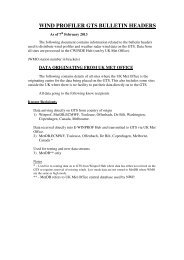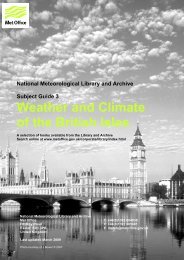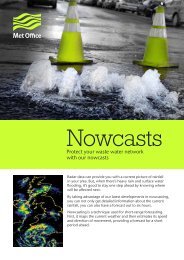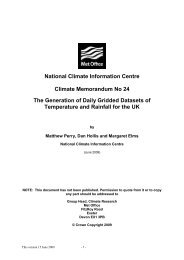Description and assessment of the OSTIA reanalysis. - Met Office
Description and assessment of the OSTIA reanalysis. - Met Office
Description and assessment of the OSTIA reanalysis. - Met Office
Create successful ePaper yourself
Turn your PDF publications into a flip-book with our unique Google optimized e-Paper software.
2.5 OSI-SAF sea-ice concentration reprocessing<br />
A daily sea ice concentration field is provided with <strong>the</strong> <strong>OSTIA</strong> <strong>reanalysis</strong>. This is used in to update<br />
<strong>the</strong> background SST field (see section 3.3) with <strong>the</strong> aim <strong>of</strong> improving <strong>the</strong> consistency between <strong>the</strong><br />
SST <strong>and</strong> <strong>the</strong> sea ice. The ice concentration field is also used in <strong>the</strong> quality control procedure to<br />
mask out observations in all <strong>of</strong> <strong>the</strong> datasets for regions which appear to be under ice (section 3.2).<br />
This is particularly important for <strong>the</strong> Pathfinder data owing to an issue <strong>of</strong> erroneous data in <strong>the</strong> Arctic<br />
in <strong>the</strong> boreal summer, discussed in section 2.2.<br />
The <strong>OSTIA</strong> ice field is derived from <strong>the</strong> OSI-SAF sea ice concentration reprocessing dataset<br />
between 1985 <strong>and</strong> 2007 (Eastwood et al., 2010) by regridding from a 10 km resolution polar stereographic<br />
grid on to <strong>the</strong> <strong>OSTIA</strong> 1/20 o equal-area grid. A QC procedure was performed by eye on <strong>the</strong><br />
ice concentration files before inclusion in <strong>the</strong> <strong>reanalysis</strong> to remove files with regions <strong>of</strong> missing or<br />
poor data. For days when <strong>the</strong> ice concentration field was not available due to satellite malfunction<br />
or planned maintenance (Tonboe <strong>and</strong> Nielsen, 2010), or did not pass our QC checks, <strong>the</strong> previous<br />
day’s ice concentration field was persisted. Appendix A gives a complete list <strong>of</strong> missing days.<br />
For large gaps in <strong>the</strong> data (7 days or more), <strong>the</strong> first file available after <strong>the</strong> outage has been<br />
copied to <strong>the</strong> date in <strong>the</strong> middle <strong>of</strong> <strong>the</strong> outage. This is because (making <strong>the</strong> assumption that <strong>the</strong><br />
growth/retreat <strong>of</strong> ice extent can be approximated as linear) after <strong>the</strong> halfway point <strong>the</strong> ice concentration<br />
field will be closer to that in <strong>the</strong> later file, <strong>and</strong> less close to that persisted from <strong>the</strong> file at <strong>the</strong> start<br />
<strong>of</strong> <strong>the</strong> outage. This aims to reduce large jumps in <strong>the</strong> SST <strong>and</strong> sea ice consistency. This method<br />
could be improved, for example by using an interpolation method for <strong>the</strong> sea ice concentration in<br />
<strong>the</strong> data gap to produce a daily file. Analysis <strong>of</strong> <strong>the</strong> effectiveness <strong>of</strong> this procedure is included in<br />
section 4.4.2.<br />
Areas <strong>of</strong> missing data in <strong>the</strong> ice concentration field due to missing scan lines, missing orbits<br />
<strong>and</strong> <strong>the</strong> polar observation hole were filled by OSI-SAF. This was accomplished using an algorithm<br />
employing both spatial <strong>and</strong> temporal interpolation (Eastwood et al., 2010). However, for this version<br />
<strong>of</strong> <strong>the</strong> reprocessed ice concentration data <strong>the</strong>re still remained missing data within some sea ice files.<br />
For missing regions enclosed within <strong>the</strong> ice concentration field a spatial 2-D bilinear interpolation<br />
was used during <strong>the</strong> <strong>OSTIA</strong> regridding process. For missing regions which extended beyond <strong>the</strong><br />
ice edge <strong>the</strong> region could not be filled using this method <strong>and</strong> <strong>the</strong> file was rejected. Over open water<br />
<strong>the</strong> effect <strong>of</strong> atmospheric noise on <strong>the</strong> passive microwave sensor increases <strong>the</strong> ice concentration<br />
above 0% (Tonboe <strong>and</strong> Nielsen, 2010). Therefore data with a concentration <strong>of</strong> less than 15% was<br />
set to 0% for <strong>the</strong> <strong>OSTIA</strong> <strong>reanalysis</strong>.<br />
The OSI-SAF sea ice concentration dataset is comprised <strong>of</strong> data from <strong>the</strong> SMMR (Scanning<br />
Multichannel Microwave Radiometer) instrument between January 1985 <strong>and</strong> July 1987 <strong>and</strong> <strong>the</strong><br />
various SSM/I (Special Sensor Microwave/Imager) instruments between July 1987 <strong>and</strong> December<br />
2007. Lists <strong>of</strong> <strong>the</strong> satellites carrying <strong>the</strong> instruments <strong>and</strong> overlap periods between instruments are<br />
given by Eastwood et al. (2010). The SMMR instrument, aboard <strong>the</strong> Nimbus 7 satellite, operated<br />
© c Crown Copyright 2011 21




